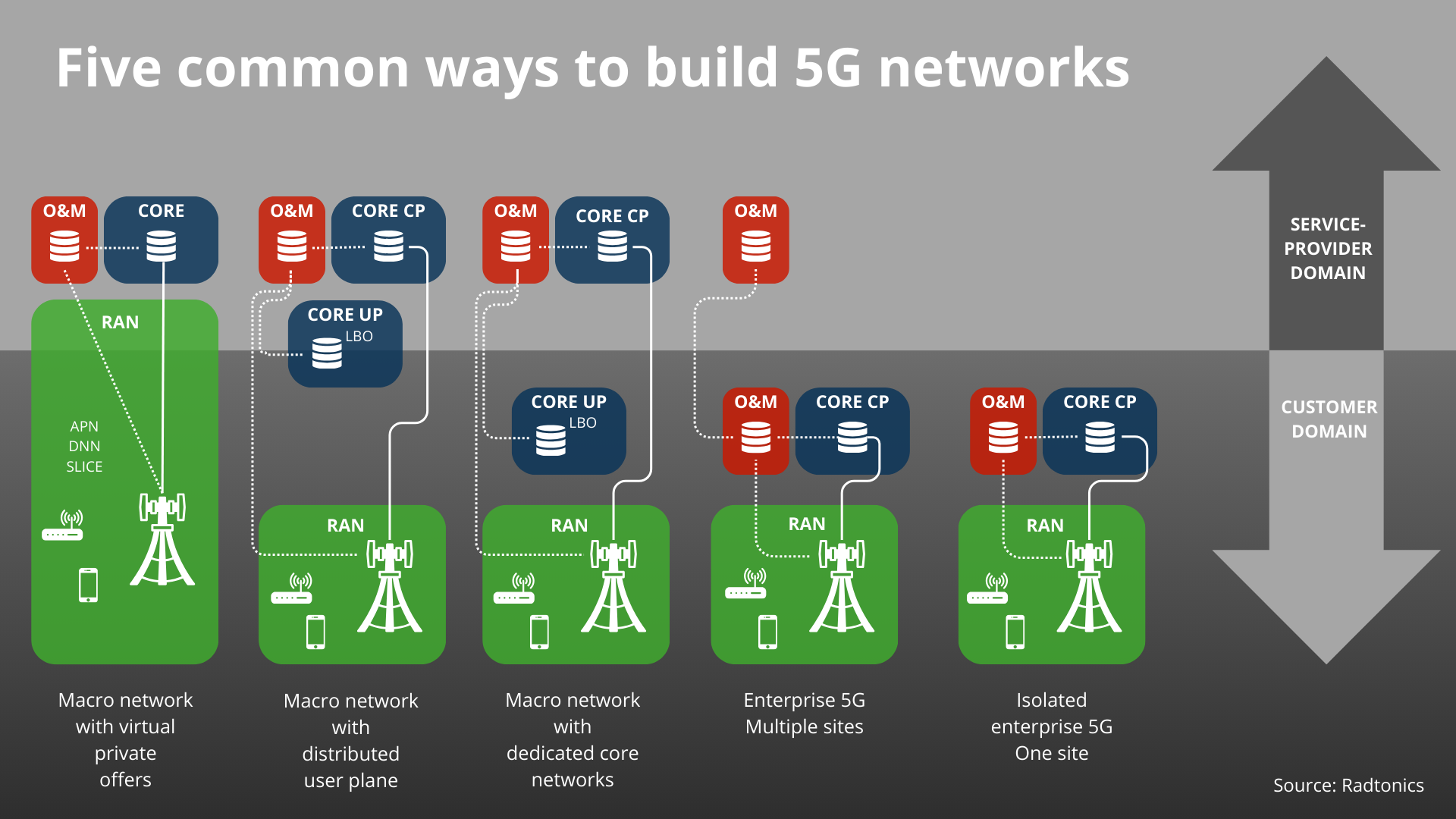Over the past year, private 5G has increasingly featured in discussions about wireless, local networks. So, what is a private 5G network, and why is there a need for one?
Firstly, finding ONE explanation of what a private 5G network is difficult, as there are several interpretations of the definition. So, let’s not start by dissecting the different explanations, but rather begin with why there is a need for a private 5G network.
5G Replacing WiFi?
Private 5G is encroaching on WiFi’s territory, but this does not mean that private 5G is a replacement for home WiFi, or even corporate WiFi at present. The pioneer companies that are investing in private 5G networks as a solution instead of WiFi today are not doing so to get a less laggy gaming experience, but are organizations with a real need to replace WiFi with a technology that better suits their operations.
Advocates for private 5G argue that its biggest strengths compared to WiFi are better range and mobility, as well as higher security and prioritization. A 5G radio has a longer reach than WiFi and does not have the same issues with wave propagation around obstacles thanks to a better link budget – these are the main arguments. But it can also be about seeking a replacement for the public 5G network in terms of capacity. Perhaps one is in a place where capacity is affected, for example, by large events, or an influx of tourists at certain times of the year, which drastically reduces performance at the local site for the public networks.
Permits for Each Network
 If one wishes to apply for permits for local private 5G networks, the application is made to the Swedish Post and Telecom Authority (PTS). It is a formality that requires specifying where the network will be used, and once you have your permit, you have six months to set up the network; otherwise, the permit is forfeited. The first network at a location is easy to get a permit for, but if you plan to set up two networks in the same property or with overlapping areas, it may require a bit of adjustment and communication with the PTS. It is also the case that private 5G networks need to be timed with the surrounding 5G networks so that they do not interfere with each other. So, it requires a bit more planning to build the networks than to set up a corresponding WiFi network.
If one wishes to apply for permits for local private 5G networks, the application is made to the Swedish Post and Telecom Authority (PTS). It is a formality that requires specifying where the network will be used, and once you have your permit, you have six months to set up the network; otherwise, the permit is forfeited. The first network at a location is easy to get a permit for, but if you plan to set up two networks in the same property or with overlapping areas, it may require a bit of adjustment and communication with the PTS. It is also the case that private 5G networks need to be timed with the surrounding 5G networks so that they do not interfere with each other. So, it requires a bit more planning to build the networks than to set up a corresponding WiFi network.
Many describe collaboration with the PTS as positive, but there are potential problems for those who want to build private 5G networks. – The permits make it very difficult to build outdoors on smaller properties because the signal strength requirements are very stringent and only devices within the property are allowed to connect. Another problem is temporary workplaces, such as a temporary logging site in the forest, where you may only need a permit for a month. These permits should not be based on property but rather on a geographical area, says Tommy Ljunggren of Ljunggren Consulting Team.
Defining a Private 5G Network
Private 5G networks are built either by or in collaboration with the major mobile operators, or they are built by companies that offer services and networks independent of the public networks and operators.
According to Alex Jonsson at RISE, there are several ways to view it. There is no clear boundary of what is a private 5G network, but there is no right or wrong. Either a private 5G network can be a network where one has a slice of the operator’s spectrum for the so-called macro network, i.e., the operator’s “normal public network”. Or one has a private 5G network with a local permit on 3.7 GHz, the so-called N78 band. So, private 5G can be either a private 5G network at the macro level against an operator’s network, or a private 5G network at the local level with its own network.
Beyond technology, private 5G is primarily about offering added value beyond the network. – The value for the customer is several with mobile private networks, including autonomy, QoS, security, low response times, mobility, prioritization, or other customer-specific specially configured network parameters. Regardless, it is about the customer getting a specially tailored configuration of the network where the solution is protected and value-based. Technically, we can fulfill this value with many different solutions, says Malina Borg-Sigg of Telenor.
So how should one view these two solutions?
A private 5G network at the macro level with private APN and network slicing is a solution where one creates the feeling of a private network in the public network and avoids having traffic pass through the internet. -The advantage of a virtual private network is that it can work within the entire coverage area of the public operator and in some cases even abroad. The disadvantage is that one is entirely dependent on the public network, which means that the robustness is that provided by the operator and one’s data still passes through the mobile network, says Tommy Ljunggren of Ljunggren Consulting Team.
The aspect that is particularly important for the customer to consider is that you do not get an autonomous system in this case, and if the connection to the operator is interrupted, production in the factory or sawmill is likely to stop.
In a private 5G network, one builds their own so-called core network with their own radio infrastructure, and manages the network themselves. The core network can be cloud-based or installed on-site, an on-prem system. Many companies require that the private network has local survival even if the connection to the internet or any operator is interrupted, and then a local network per installation site is required.
Five Ways to Build 5G Networks
There are five different ways to build 5G networks, says Oscar Bexell of Radtonics, referring to the model below.

– Farthest to the left, we have the operators’ traditional model with private networks via APN or a slice of the spectrum. Operators are also looking at models 2 and 3. The second figure is about building decentralized core networks to be able to break out traffic closer to the customer. Then, as a third step, operators want to offer a solution like figure three with “local breakout” where one breaks out the user plane locally but keeps the control plane, authentication, etc., centrally. The two figures on the right are those where the customer gets their own, local network that they control, which is autonomous, where they can plan capacity themselves, and where everything connects with the IT infrastructure, says Oscar.
Operators and Private, Local 5G Networks
So are only the public macro networks and private APN or network slicing appealing to operators? Linda Ekener Mägi of Tele2 explains that what Tele2 defines as private 5G is a completely autonomous system with its own core network and own radio infrastructure that is built on the customer’s property on a frequency assigned to the customer by the PTS. The private 5G network lacks roaming or connection possibilities to the public 5G network since the customer has unique SIM cards for their private network.
Other Solutions?
The two biggest competing solutions to 5G, if we talk about wireless standards, are Starlink and WiFi, where Starlink is perhaps more of a competitor to the operators’ macro networks where the public 5G networks have difficulty reaching today. Using Starlink as a way out to the internet for a local private 5G network is a theoretical possibility for those who want to build 5G networks where it is difficult to find an internet connection. But one should remember that Starlink does not have any SLAs or guarantees, Starlink is a best effort service.
WiFi is a local solution that can handle large amounts of data with low latency indoors. In some cases, WiFi may be a better alternative if one has stationary objects, such as a surveillance camera, that should send a lot of data traffic in the uplink but does not have such a great need in the downlink. Private 5G runs on a licensed frequency that no one else on the site can use. WiFi is unlicensed and thus others can use the frequency, which affects availability.
So to summarize, if predictable capacity is important, private 5G may be a better alternative. If a WiFi or Private 5G is to communicate with the outside world, an internet connection is needed, then public 5G or Starlink can be an option, but if you are building a local network, WiFi or private 5G networks can function autonomously.
Private 5G networks, regardless of form, will grow significantly in the coming years. But it’s important to know what you’re doing; it’s not like WiFi where, in its simplest form, you can go down to the local store and buy a network.
-One thing/experience that I’ve picked up at several companies that build private networks is the problems with terminals and “compatibility”, where you need to collaborate even with those who provide hardware on the device side, says Tommy Ljunggren of Ljunggren Consulting Team.
-If you have business-critical applications, maybe you want to have your own discretion, i.e., run everything locally, concludes Linda Ekener Mägi of Tele2.
This article was published in Elektroniktidningen #1 · 2024.

